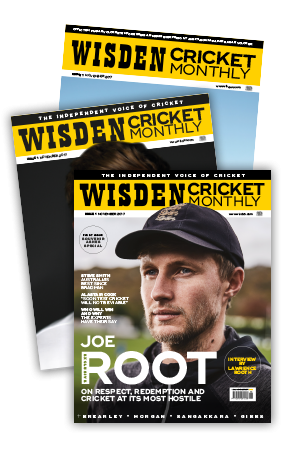Nick Knight, Roger Twose and the rest: Wisden’s ‘Pure Nineties’ ODI XI

 by Abhishek Mukherjee
by Abhishek Mukherjee
@ovshake42 3 minute read
With enough distance we can say it now: The 1990s was the decade when ODI cricket peaked.
One-Day Internationals had started in 1970/71, but they really took off since the 1992 World Cup. As coloured attire, a white ball (two of them at the start), and fielding restrictions were added, ODIs found their identity. New tactics came in. ‘Pinch hitters’ became popular. As the decade progressed, South Africa emerged as one of the strongest sides in the world, Sri Lanka established themselves, and the open-market economic policy helped India evolve into the largest television audience in the cricketing world.
The organisers noticed the change, and matches increased. Only 698 ODIs had been played until the end of 1991; 833 more were added over the next eight years. The World Cup increased to 12 teams, the Champions Trophy was introduced, the Under-19 World Cup became biennial, ODIs featured in the Commonwealth Games, Sharjah became a go-to venue (about 11.5 percent of ODIs in the 1990s were held there), and cricket spread as far and wide as Singapore and Toronto.
ODIs broke away from Test cricket. When Australia toured South Africa in 1997/98, they had separate squads under separate captains for the two formats. They had figured out – like several other sides around that period – that being a regular international cricketer was no longer dependent on one’s prowess in Test cricket.
There were a whole host of ODI greats in the 1990s. But for this XI, we’re not really interested in them. Instead, we want a team who captured the unique vibe of the decade, that feeling that at any given time, somewhere in the world, at least a few of these players would be dutifully going about their business in 50-over cricket.
Kennedy Otieno (wicketkeeper)
Picking a Kenyan is only fair – they never got to play Test cricket and yet, one cannot think of ODIs in the 1990s without Kenya. In his second ODI, Otieno made 82 against Australia on either side of retiring with cramps (very 90s) – the first great innings by a Kenyan. The next year, he made 144, putting on what was then a world-record opening stand of 225 with Dipak Chudasama, and followed it with 87. Solid in front of the stumps and reliable behind them, Otieno will open batting for the side.
Nick Knight
Knight averaged over forty with the bat – and even that seemed too few when he was on song – which makes him an automatic choice at the top. In true 1990s fashion, despite being one of England’s better ODI players of the era, he didn’t played in a World Cup game in the decade. He debuted just after the 1996 World Cup (with two hundreds in his first three matches) and lost form just ahead of the 1999 edition.
Roger Twose
The famous Twose anecdote (he was asked to change his surname to hundreds after he got three consecutive scores of two and four in five innings) is about his poor Test career. In ODIs, he scaled greater heights, scoring 2,717 runs at 39. His most famous innings was perhaps the unbeaten 80 against Australia in the 1999 World Cup, but his brilliant 103 in Cape Town in the new millennium was no less remarkable. The Kiwis were always there or thereabouts in the 1990s (perhaps you can say the same of any decade), quietly churning out results but never quite threatening a global triumph. And no one sums up unnoticed credibility like Roger Twose.
Neil Fairbrother
To the non-English cricket fraternity, Fairbrother seemed to be someone England unearthed during World Cups. You cannot blame them, for he played more than a quarter of his 75 matches across three World Cups. And in these three tournaments, no English batter had more runs at a better average. Unlike Neil Harvey, the man he was named after, he never mastered Test cricket, but he was an expert at picking up gaps and running between the wickets, particularly towards the end of an innings. He would have been hailed as a top ODI finisher today.
Dave Callaghan
Diagnosed with testicular cancer, Callaghan debuted after he had undergone his last chemotherapy session. Eighteen ODIs into his career, his career was going nowhere. He had not played a Test match, did not have a fifty, averaged under 20, and had only six wickets. Then came the famous Centurion ODI, when South Africa sent him to open. He slammed 169 not out in 143 balls – then the fifth-highest ODI score – and took a career-best 3-32. He never made another fifty, but he had done his bit to make it to this side. What is more 1990s than a bolt-from-the-blue, never-to-be-repeated performance after some tactical funkiness?
Robin Singh
In 1988/89, Robin Singh was cheered on India debut by local Trinidadian fans – for it was also his country of birth. He was then left out for seven years. In ODIs, Robin Singh made a hundred but averaged 26, took two five-wicket hauls but averaged 43, and played a lone Test match. Yet, he remained a permanent fixture in the Indian side – perhaps because of his fielding, or perhaps because the team balance demanded him. The prototype ODI cricketer of the 1990s.
Chris Harris
Non-spin with a leg-break grip was perhaps what described Harris most. Or perhaps he bowled medium-pace (with an action that Virat Kohli imitated, almost certainly unintentionally). Yet, Harris became the first New Zealand cricketer to play 250 ODIs or take 200 wickets. He remained not out in 29 percent of his innings (including a run of eight) but averaged only 20.44 from 23 Test matches. New Zealand of the 1990s were unthinkable without him.
Kumar Dharmasena (captain)
Dharmasena picked up only six wickets in the 1996 World Cup, but went for a mere 4.44 an over, wheeling away through the middle overs with a straight, flat trajectory on slow pitches, proving extremely useful in Sri Lanka’s title quest. The tournament mirrored his career, over the course of which he conceded 4.27 but picked up fewer than a wicket a match. For Sri Lanka, only Muttiah Muralitharan and Chaminda Vaas had better economy rates during Dharmasena’s career; but unlike Dharmasena, neither made four ODI fifties.
There is no obvious captain in this side, but being an umpire, he can be in charge of two teams. Surely he can handle one?
Shane Lee
Lee batted in the top six only six times, never scored a fifty, and bowled under six and a half overs a match. So why did he play 45 ODIs? Because until Lee’s retirement, only Kapil Dev and Lance Cairns struck at quicker than his 95 and had an economy of better than his 4.37. Lee could also throw bazookas from the outfield. It is a shame that he is not even the most famous cricketer in the family.
Nikhil Chopra
However hard you try, it is unlikely that you will be able to remember anything bowled by Chopra in international cricket (did you know he also played a Test match?). That was perhaps because he bowled line-and-length, to the field, varying pace, but seldom attacking. Yet, of the Indian spinners who bowled more balls in ODIs, only Maninder Singh has a better economy than his 4.20 – and Maninder played mostly in the 1980s. Oh, he also got a 61 against the West Indies.
Gavin Larsen
The dibbly-dobbliest of all dibbly-dobbly bowlers, ‘The Postman’ earned his nickname for his metronomic precision: he always delivers. Every ball was on target, with no room for the batter, or no pace to work upon. He debuted in the first year of the 1990s and retired after the last year, and finished with a ridiculous economy rate of 3.76. In World Cups, that dropped to 3.52.

